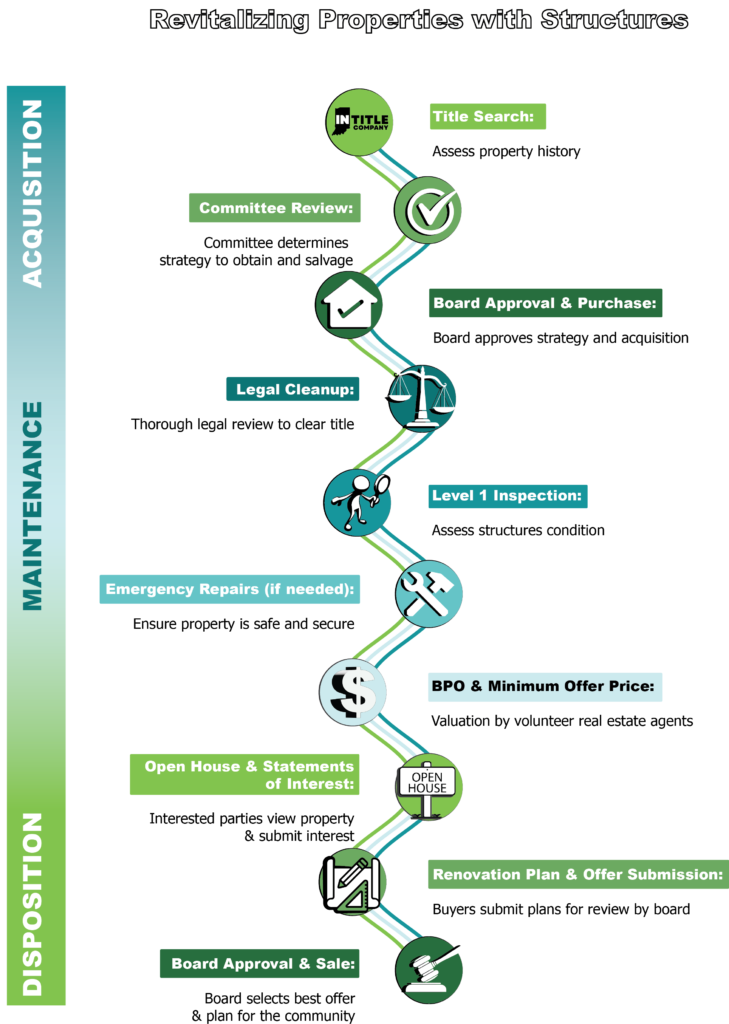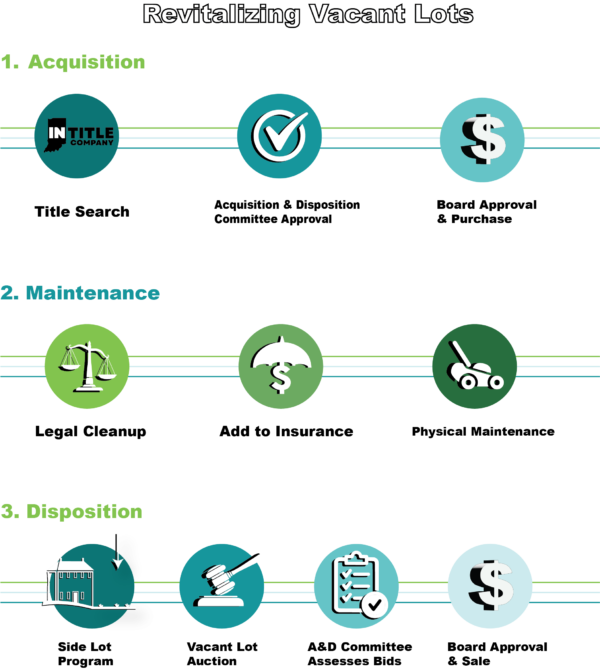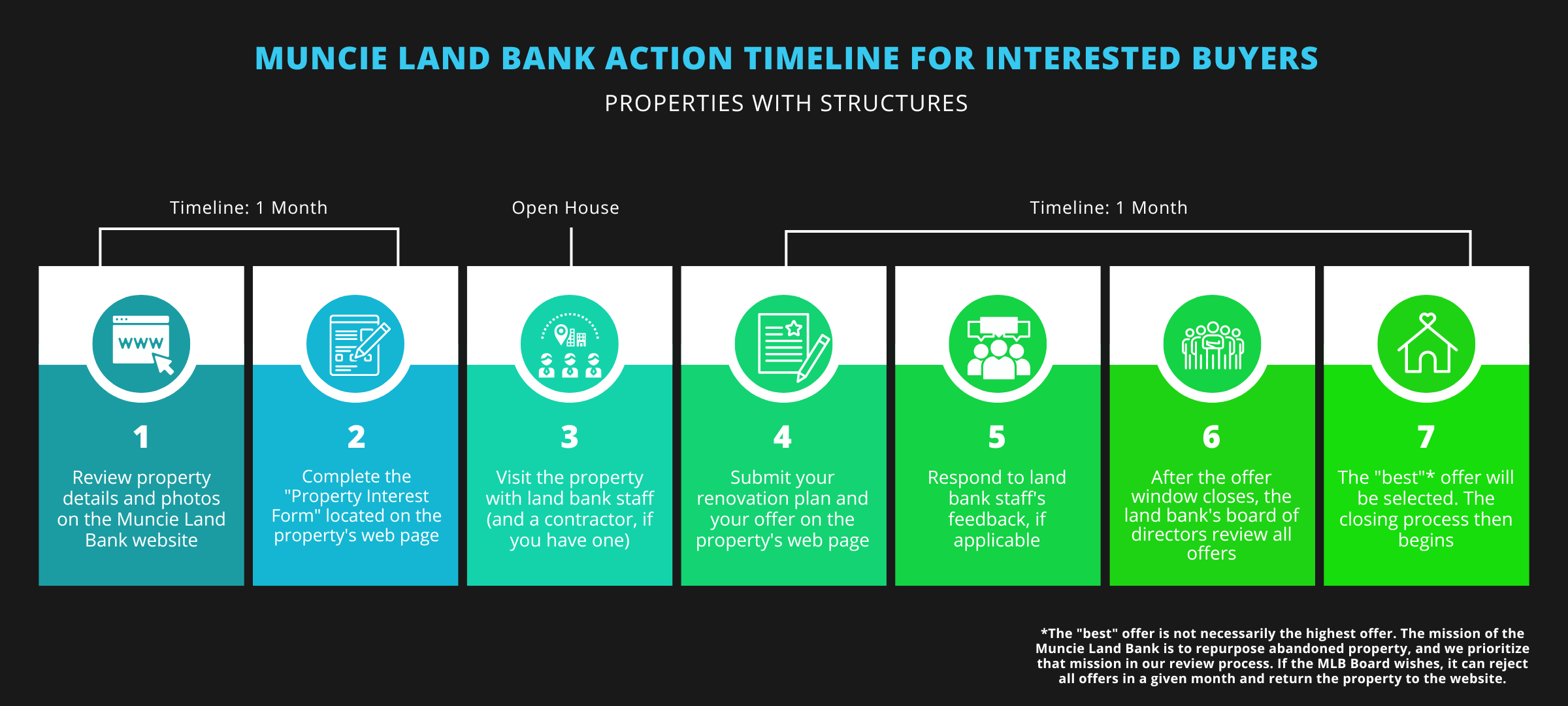An In-Depth Look at our Processes
The mission of the Muncie Land Bank is to acquire abandoned property, preserve it, and provide it to the public for strategic redevelopment. Because we are a mission-based organization, our aim is not to profit off of abandoned land, but to see that land return to the city of Muncie’s tax rolls and become
productive once again. This process requires that the land bank extensively vet our buyers, but it also means that our properties are generally more accessible to local residents than properties that are simply sold at the highest market price. In order to redistribute the properties to bidders, the Muncie Land Bank has three separate property disposition processes.
Vacant Lots
When the Muncie Land Bank first acquires a vacant lot, we both physically and legally clean that property. A title search is ran, and all liens and civil penalties are cleared. As the Muncie Land Bank intends to serve the residents of the City of Muncie, we take great care to thoroughly examine each lot before selling it to a new owner.
We then place that lot into our side lot program. Postcards are sent to adjacent property owners in order to notify them that the property is for sale. At this point in the process, only adjacent property owners are able to purchase a side lot property. The properties are available on our side lot program for a period of 45 days, and are available to adjacent owners for a reduced price. In the case where two adjacent owners want to split a parcel, the Muncie Land Bank will work with both owners to grant them the land.
After this 45 day period is over, the side lot properties graduate into our regular vacant lot auction. Our regular vacant lot auction runs through our website each month, and buyers are vetted by Muncie Land Bank staff members to ensure that their projects conform with Delaware County zoning ordinances and that the buyers’ projects will benefit the Muncie community. Ultimately, the Muncie Land Bank board of directors approve or deny bids, approving the “highest and best” bids. This means that the board of directors will not always accept the highest bid on a property, but will accept the highest bid that they believe will benefit the community.
Some bids may be approved, but may come with deed restrictions. These deed restrictions will allow the Muncie Land Bank to retake the property if the winning bidder does not conform to certain stipulations, such as keeping the grass mowed or conforming to local ordinances. In these cases, the deed restrictions typically expire after one year of responsible ownership, unless explicitly stated otherwise.
Properties with Structures
 In some cases, the Muncie Land Bank will acquire properties with structures already built on them. The process here is much more complicated than with vacant lots. Whenever the land bank acquires a property with a structure, we first thoroughly clean the property of all legal issues. This period may take the land bank several months.
In some cases, the Muncie Land Bank will acquire properties with structures already built on them. The process here is much more complicated than with vacant lots. Whenever the land bank acquires a property with a structure, we first thoroughly clean the property of all legal issues. This period may take the land bank several months.
Once the legal process is complete, a “Level 1 Inspection” is performed to gather basic information about the condition of a structure, and the Muncie Land Bank determines whether the structure needs to be demolished or can be rehabbed. If a property can be rehabbed, the Muncie Land Bank will perform any emergency repairs that the structure may need. A BPO (broker’s price opinion) is performed by local real estate agents who volunteer their time to the land bank, and a minimum offer price is set.
After the property is legally cleaned and emergency repairs are made, the land bank lists the property on our website. During this period, all interested parties can submit a “statement of interest” to convey interest in the property to land bank staff. Parties who submit statement of interests will be invited to view the house.
Rather than using a standard auction process for properties with structures, the land bank invites each party that attended the open house to submit a renovation plan, as well as an offer on the property. Each party’s renovation plan and offer will be considered by the board of directors in their evaluation on whether to sell the property. A visual projection of this process is shown below.



